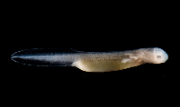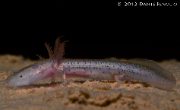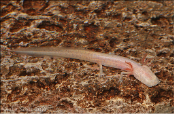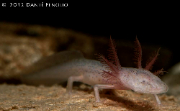Georgia Blind Salamander (Eurycea wallacei)
Description: Blind Salamanders are fairly small -- 2-3 inches long, paedomorphic (adults remain aquatic and retain larval characteristics) salamanders that are highly adapted to life in caves. They have no eyes and little pigment on their body, making them pinkish white in color and somewhat iridescent. They have long, red external gills, a broad head, and skinny legs. Have 12-13 costal grooves.
Habitat: This species inhabits the Marianna Lowlands-Dougherty Plain karst aquifer, within which it is found in subterranean streams and clear pools. These areas are characterized by limestone substrates often covered in a fine red clay or silt. Individuals are often found at the bottom of pools and other areas with low flow, and have also been observed climbing on sidewalls, ledges, and ceilings of submerged passages. This species may be dependent on guano from associated bat populations.
Range: The Georgia blind salamander is found in underground habitats in the Southeastern United States. Its precise distribution is unknown, however the first specimen to be examined scientifically was discovered in 1939 in water pumped from a deep well in Albany, Georgia. The only other locality in Georgia from which it is known is the Climax Cave, near Climax, Georgia, in Decatur County. The salamander is also known from at least eight locations near Marianna in Jackson County, Florida. All these locations are connected to the Floridan aquifer, a vast system of underground water-filled passageways in limestone which underlies much of the Southeastern United States.
Found in these States:
FL |
GA
Diet: Very little is known about the biology of this salamander. It feeds on ostracods, amphipods, isopods, copepods and other small aquatic prey.
Reproduction: Females with developing eggs have been found in May and November and it is thought that breeding may take place at any time of year. It appears to remain neotenic (breeding in its larval state) and no metamorphosised individuals have ever been found.
Status: Listed as Endangered because its extent of occurrence (EOO) is 3,941 km2, it occurs in five or fewer threat-defined locations, and there is continuing decline in the extent and quality of its subterranean aquatic habitat in Georgia and Florida in the United States.
Taxonomy: The Georgia blind salamander was originally described as a member of the monotypic genus Haideotriton, but was later placed in the genus Eurycea.
»» Kingdom: Animalia - Animals
»» Phylum: Chordata - Chordates
»» Subphylum: Vertebrata - Vertebrates
»» Class: Amphibia - (Amphibians)
»» Order: Caudata - Salamanders
»» Family: Plethodontidae - Lungless Salamanders
»» Genus: Eurycea
»» Species: Eurycea wallacei - Georgia Blind Salamander
This article uses material from the Wikipedia article "Georgia Blind Salamander", which is released under the Creative Commons Attribution-Share-Alike License 3.0. Content may have been omitted from the original, but no content has been changed or extended.
|






